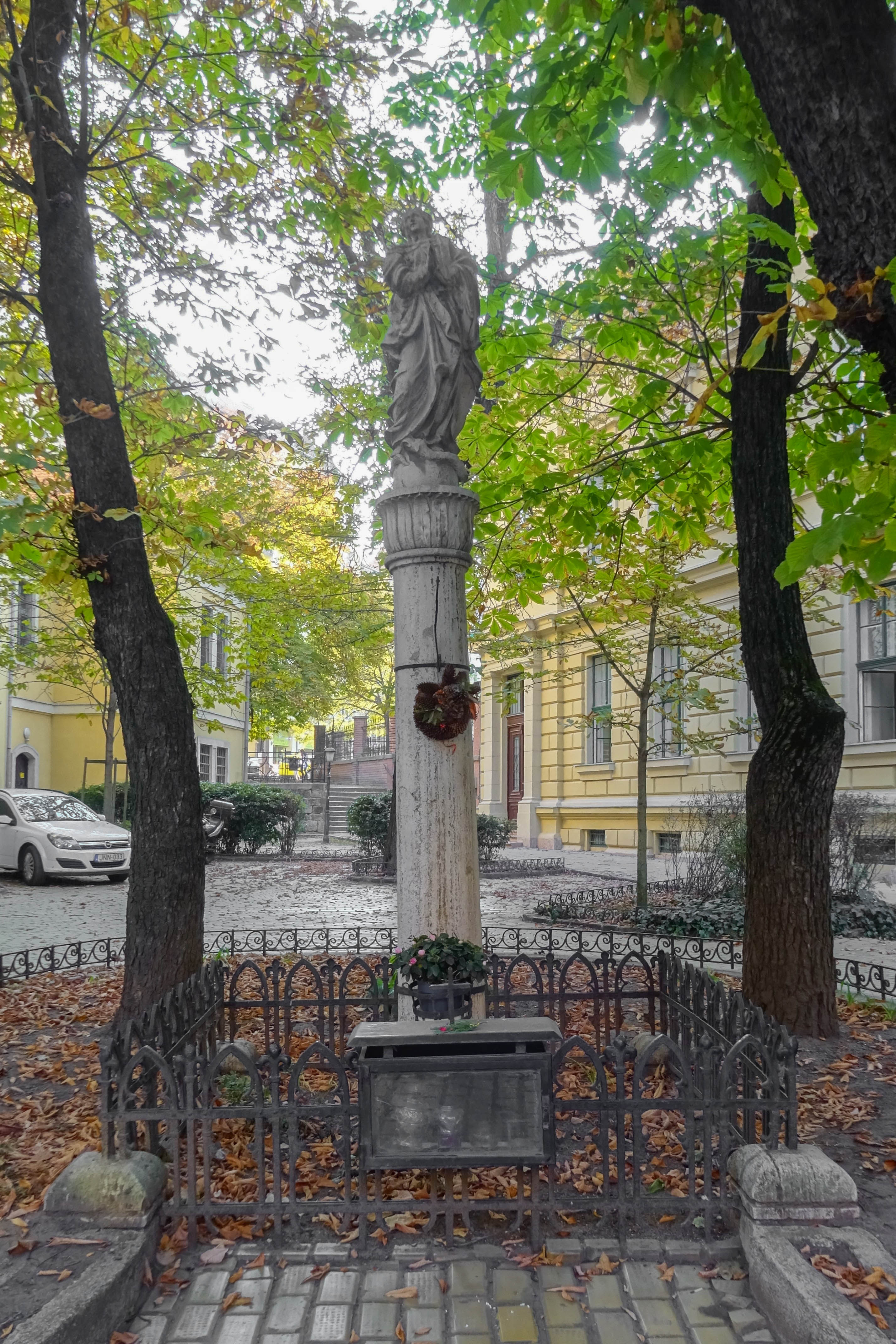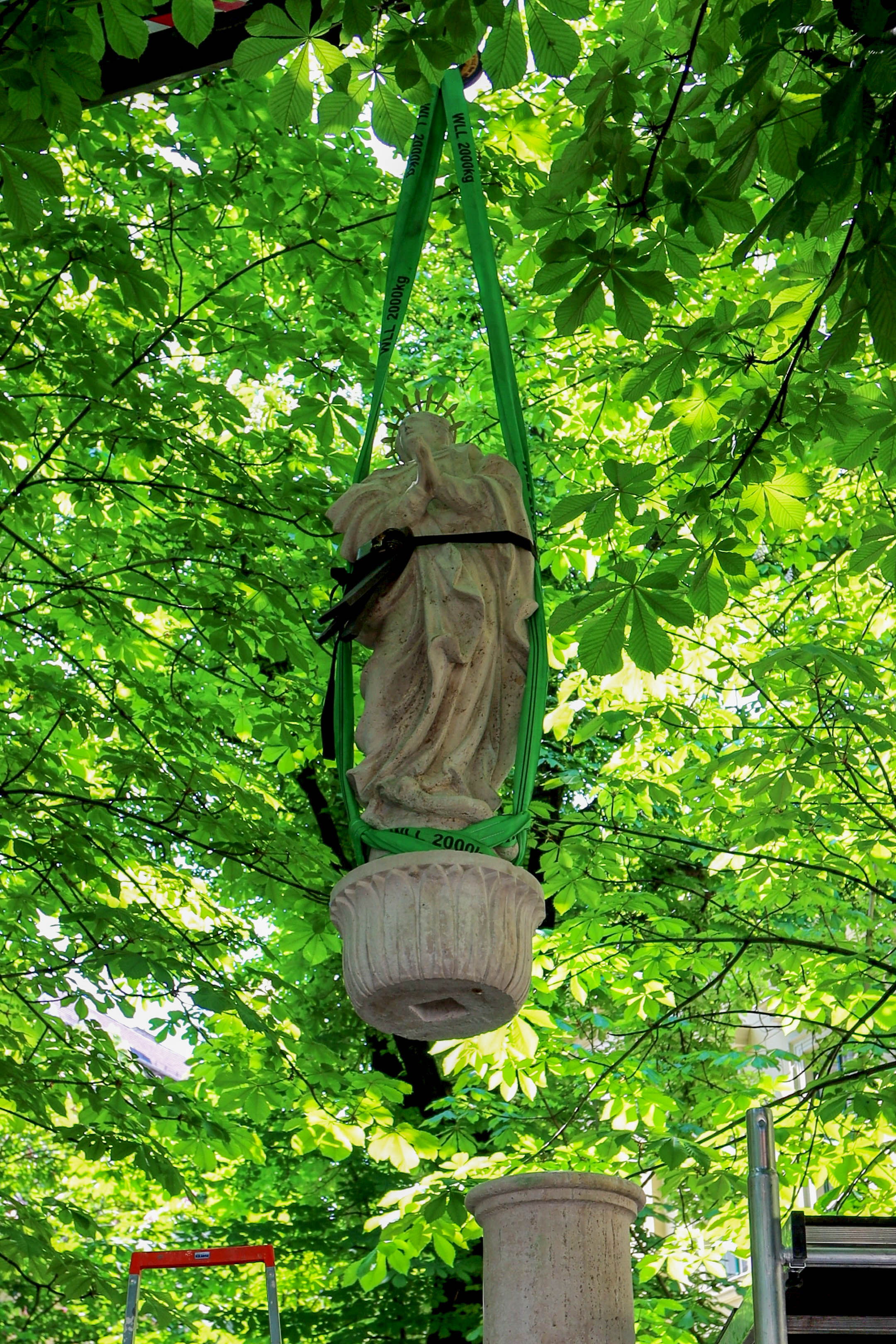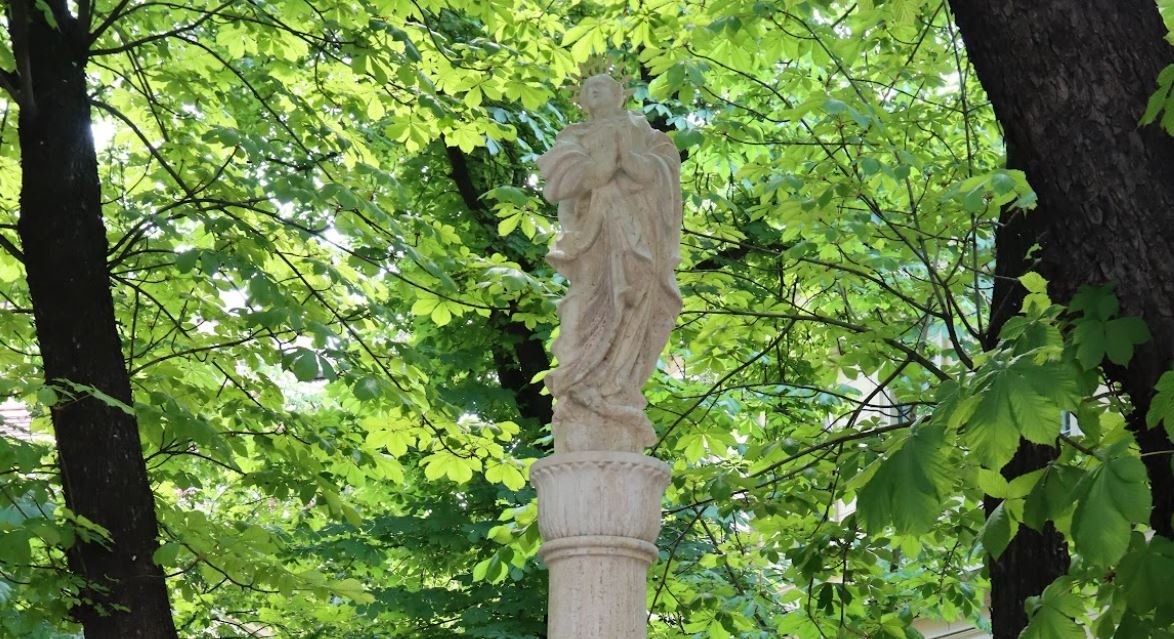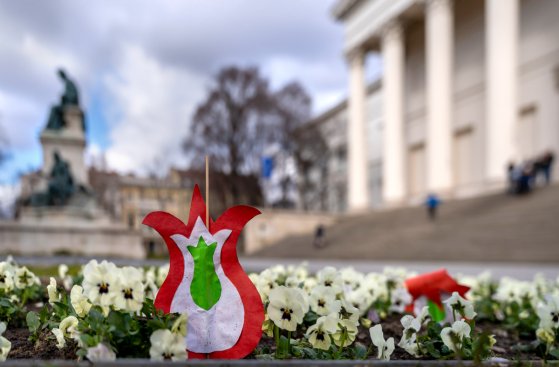In Buda, in the heart of Krisztinaváros, a small square with an intimate atmosphere houses a statue of the Virgin Mary on a column. Under the chestnut trees of the square, which is bordered by the church on the right and the church school on the left and is part of part of Krisztina Square , the place of the sculpture was empty for a while: the statue and its column were taken to the restoration worshop of the Hungarian University of Fine Arts in Epreskert, where the restoration was carried out under the coordination of the Budapest History Museum - Budapest Gallery, which is responisble for the upkeep of public statues, with the support of the Budapest Local Government.
Photograph of the Immaculata statue in Krisztina Square in the picture supplement of the 5 August 1928 issue of Magyarság
Imola Bíró, a graduate student of the university and the restorer of the sculpture, told pestbuda.hu: the statue was taken to the restorer's studio on 18 September 2020, but the work took longer than expected, as the studio in Epreskert was closed for months due to the epidemic.

The sculpture was transported to the restorer's studio in 2019 (Photo: Department of Restoration, Hungarian University of Fine Arts)
Speaking of the condition of the statue, she said it had deteriorated quite a bit, partly due to the weather and partly due to previous unprofessional restorations. For example, they had found out that the surface of the statue and the column had previously been reworked with an angle grinder, which had left quite a deep imprint on the garments, for example. In connection with the restoration, the origin of the limestone material of the sculpture was also confirmed and clarified by isotopic measurements, in which dr. Sándor Kele, an employee of the Institute of Geology and Geochemistry, assisted her. The statue needed to be replaced in several places, for example, the right arm was an earlier addition - which we know was damaged in World War II. This has now been completely redesigned by the restorer.
The restorer redesigned the right arm of the statue due to its World War II damage (Photo: Department of Restoration, Hungarian University of Fine Arts)
The head of the statue is surrounded by a crown like halo, made of brass. In connection with this, according to Imola Bíró, it is conceivable that the crown was originally larger in size because she found a hole in the neck of the statue, which could have been used to fix the older crown.
The statue of the Immaculata statue in Krisztinaváros and the condition of the column chapter before and restored (Photo: Department of Restoration, Hungarian University of Fine Arts)
The renovated sculpture was delivered to the site on Thursday morning, 5 May 2022, by the staff of the Department of Restoration of the Hungarian University of Fine Arts, Balázs Szemerey-Kiss, the head of the department, Richárd Káldi, art teacher and Imola Bíró, the restorer of the sculpture, and they carried out the necessary work.

Placement of the sculpture to Krisztina Square on 5 May 2022 (Photo: Department of Restoration, Hungarian University of Fine Arts)
Endre Liber describes the sculpture in his work entitled Bidapest szobrai és emléktáblái [Sculptures and Plaques of Budapest]: “The sculpture stands on a round column. Under its feet is a globe around which, like the origin of all sin, the serpent twists. The Virgin Mary pleads with clasped hands for the blessing of the Almighty, a wreath of stars around her head. Its creator is unknown. ”
The statue is a so-called immaculata depiction that follows the iconography of the Immaculate Conception of the Virgin Mary, all of which have the characteristics described above, a star crown and a hand joined in prayer, and a snake whose head is trampled by Mary. According to the local tradition and the entry of the parish office - quoted by Lajos Schmall in his 1900 manuscript entitled Budapest közterein álló vallásos jellegű szobrok leírása és története [Description and History of Religious Sculptures in the Public Spaces of Budapest] - like so many contemporary religious monuments, the statement of this statue was linked to the plague.
After the restoration of the sculpture, the site works were also carried out (Photo: Department of Restoration, Hungarian University of Fine Arts)
The dreaded disease, the plague, has devastated Hungary several times from the Middle Ages until the Early Modern Period. After the recapture of Buda, in 1692, the disease, also known as the Black Death, occurred mainly in the vicinity of Buda and Pest. The plague was carried by the wounded returning from Belgrade - read in the study of Lajos Tardy and Emil Schultheisz entitled A magyarországi járványok történetéből [From the History of Epidemics in Hungary]. Perhaps related to this plague or a minor wave a few years later was the vow of the sculptor, a glass master, presumably in connection with the healing of his loved ones or himself.
Mátyás Janisch was a godly citizen of Buda, who gained significant wealth due to his diligence and frugal lifestyle. True to his vow, he intendet to give a part of it to erect a statue of Mary in the public square. By the way, Janisch, whose name appears in this form in all sources related to the statue, is most likely the same as Matthias Janosch, a city official mentioned in several places in the council minutes of the city of Buda. In the introductory study of Géra Eleonóra Erzsébet, the publisher of the minutes of the councils of the city of Buda, 1704–1707, she concludes about his name written according to German orthography that “about master Matthias Janosch, who was definitely Hungarian, it is impossible to say in retrospect if he was called Mátyás János or János Mátyás."
The statue of Immaculata of Krisztinaváros on 5 May 2022 in Krisztina Square, after its restoration (Photo: Department of Restoration, Hungarian University of Fine Arts)
However, the religious glass master did not place the statue resting on the column in its present location, but in the area that was in front of the former Alkotás House built later, at the beginning of today's Alkotás Street, in the area of the Magyar jakobinusok Square. The statue stood here for about a century and a half. However, this place was changing by the middle of the 19th century due to the construction of the southern railway, and its old tranquility was disappearing. In 1855, financed by Guido Karátsonyi and Ferenc Pflüger, the Immaculata statue was finally placed next to the parish church in Krisztina Square. According to Volume 4 of the Magyarország műemléki topográfiája [Monumental Topography of Hungary], Budapest műemlékei I. [Monuments of Budapest I], the original Baroque column was replaced at that time with a more classicist, Egyptian papyriform capital.
The parish church of Krisztinaváros before 1872. Sharp-eyed people can notice the statue of Mary to the right of the church (Image source: FSZEK Budapest Collection)
The statue has a really worthy place here next to the Parish Church of the Blessed Virgin Mary. In his article entitled Budapest-Krisztinaváros történetéhez [To the History of Budapest-Krisztinaváros], published in 1888, Lajos Németh draws attention to an interesting connection: he connects the site with the apparition of Mary in 1495, mentioned by the chronicle entitled "A magyar történelem tizedei" [Decades of Hungarian history] of Antonio Bonfini, a humanist historian in Hungary during the reign of King Matthias. According to the aforementioned Bonfini text, Miklós, a servant of a merchant named Zsigmond, at the village of Solta (Zsolca) back then, identified with this place “heard a strong roar and shocked by the unusual event, covered his eyes and ears and dropped to the ground, and when he looked up, he saw the image of the Blessed Virgin in the sky as she descended in the air with her son in a bright cloak and headed for Buda ”. According to the Catholic calendar, the event took place on 8 December, the Feast of the Immaculate Conception.
The Immaculata statue in Krisztinaváros after restoration in the studio (Photo: Department of Restoration, Hungarian University of Fine Arts)
The next significant event in the history of the sculpture after the relocation in 1855 took place in the third decade of the 20th century: its condition deteriorated so much by the mid-1920s that it was decided to transport it to a museum.
The 6 January 1928 issue of Magyarság reported on the incident as follows: "The Virgin Mary statue next to the church in Krisztina Square and the St. John statue in Széna square disappeared from their usual place, because time has damaged the monuments so much, that their public placement would cause their total destruction. The council therefore decided to demolish both statues and transport them to the capital’s museum. However, their place will not be empty for a long time, because the capital is carving new statues completely similar to the old high-value works of art, it has already ordered them and in the spring both will be erected in the old places ”.
The copy of the statue and the column was made by master carver Antal Fischer. The copy of the sculpture turned out well and became a worthy replacement for the ancient work, which is preserved in the Budapest History Museum and can be viewed in the Kiscelli Museum as part of the sculpture collection of the Budapest Gallery. The baroque work, which was slightly different from the white public version in some details, such as the position of its hands, and was coloured in contrast, was restored by Barbara Pusztai in 2018.
Cover photo: The Immaculata statue of Krisztinaváros in Krisztina Square on 5 May 2022, after its restoration (Photo: Department of Restoration, Hungarian University of Fine Arts)





































Hozzászólások
Log in or register to comment!
Login Registration